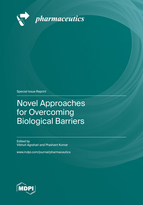Novel Approaches for Overcoming Biological Barriers
A special issue of Pharmaceutics (ISSN 1999-4923). This special issue belongs to the section "Biopharmaceutics".
Deadline for manuscript submissions: closed (20 July 2022) | Viewed by 49320
Special Issue Editors
Interests: biomaterials; biologics; long-term drug delivery; nanomedicine; hydrogels; ocular; inner ear
Special Issues, Collections and Topics in MDPI journals
Interests: vaccine; human vaccines; vaccine development; formulation development; attenuated vaccine; viral vaccines; bacterial vaccines; subunit vaccines; pediatric vaccines; COVID vaccines; measles and rubella vaccines; rotavirus vaccine; HPV vaccine; Shigella vaccine; Salmonella vaccine; combination vaccines; polio vaccine; stability study; potency assay; analytical assays; preclinical study; immunogenicity study; biophysical characterization; adjuvants; scale-up; technology transfer
Special Issues, Collections and Topics in MDPI journals
Special Issue Information
Dear Colleagues,
Biological barriers act as the key interface between organs and tissues by protecting them against “foreign materials” and allowing only specific molecules to cross, e.g., by receptor-regulated transcytosis. The selective permeability of biological barriers and the growing trend to use large molecules as next generation therapeutics makes it challenging to deliver drugs to specific targets in our body. Use of physical enhancement methods, chemical permeation enhancers, activation/inhibition of transports, biomolecules, nanotechnology, microneedles, biomimetics, and engineered biomaterials, etc., have been demonstrated to allow overcoming biological barriers. This Special Issue serves to provide readers with an overview of the novel approaches and new therapeutic modalities being used to target sites across biological barriers. We are interested in articles related to quantitative and mechanistic studies using in vitro models, in vivo trials, and translational challenges for enhancing drug delivery across biological barriers and for applications in the pharmaceutical industry.
Dr. Vibhuti Agrahari
Dr. Prashant Kumar
Guest Editors
Manuscript Submission Information
Manuscripts should be submitted online at www.mdpi.com by registering and logging in to this website. Once you are registered, click here to go to the submission form. Manuscripts can be submitted until the deadline. All submissions that pass pre-check are peer-reviewed. Accepted papers will be published continuously in the journal (as soon as accepted) and will be listed together on the special issue website. Research articles, review articles as well as short communications are invited. For planned papers, a title and short abstract (about 100 words) can be sent to the Editorial Office for announcement on this website.
Submitted manuscripts should not have been published previously, nor be under consideration for publication elsewhere (except conference proceedings papers). All manuscripts are thoroughly refereed through a single-blind peer-review process. A guide for authors and other relevant information for submission of manuscripts is available on the Instructions for Authors page. Pharmaceutics is an international peer-reviewed open access monthly journal published by MDPI.
Please visit the Instructions for Authors page before submitting a manuscript. The Article Processing Charge (APC) for publication in this open access journal is 2900 CHF (Swiss Francs). Submitted papers should be well formatted and use good English. Authors may use MDPI's English editing service prior to publication or during author revisions.
Keywords
- drug delivery
- transdermal transport
- blood–brain barrier
- permeation enhancers
- transporters
- nanoparticles
- microneedles







